Everyone knows the importance of good branding when it comes to your business—but what about building a personal brand that’s associated with you as an individual? Never underestimate the power of personal branding—when done right it can be your most valuable asset.
But how do you create a successful personal brand?
This article is going to show you the secrets of personal branding and walk you through the steps you need to take if you want to create an outstanding personal brand for yourself.
Let’s start with a definition of what personal branding actually is all about:
What is personal branding?
—
Personal branding is what shapes the perception of an individual in the eyes of the public. Personal branding is all about building your reputation, creating an image of yourself for the outside world and marketing yourself as an individual. Essentially, your personal brand is the story that’s told about you when you’re not in the room.
It may feel a bit uncomfortable to think of yourself as a brand. But the truth is that everyone already has a personal brand. What do people say about your work? What adjectives do they use to describe you? Are they positive or critical?
Your story is also being told online. What’s being said about you in the virtual space? You have a choice to actively manage your brand or leave it to chance.
Building a personal brand intentionally will allow you to tell your story as you want it to be told, to establish yourself as an expert and leader in your field and to connect with your customers and clients beyond your products and services alone.
Personal brand examples
There are some characters in the world of business who are larger than life. They’ve mastered the art of personal branding and they know exactly who they are and what makes them unique.

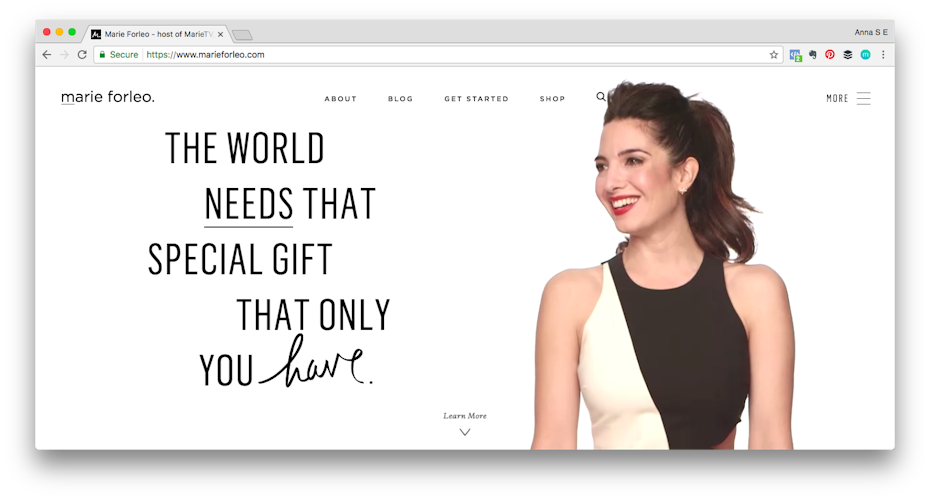
Another great example is Marie Forleo’s personal brand, which is built around her own quirky personality and motivational, supportive attitude. Her personal brand is beautifully designed, has an authentic feel and is all about encouragement for female entrepreneurs.
Examples of outstanding personal brands are everywhere—and the way an individual chooses to shape their personal brand depends on what image they want to create and what they want to achieve. Think Oprah. Richard Branson. Beyoncé. Gordon Ramsay. Personal branding can be extremely diverse.
Look at virtually any successful Youtuber, blogger or business person with an online fan base and you’ll see that their personal brand plays a major role in their success. It’s their personality that makes them approachable, trustworthy and memorable. Their businesses are built around them as a person, which makes their business and person literally inseparable. Personal branding is their biggest asset.
So, how do you actually go about building a personal brand? Here are the 5 steps you need to think about:
1. Understand why you’re building a personal brand
—
Okay, so it’s clear that you need a personal brand if you want to be successful. But how exactly is it going to help you? What are your specific reasons for wanting to create a strong brand? Getting clear about what you’re trying to achieve with your brand will help you map out the steps to get there.
Personal branding for freelancers
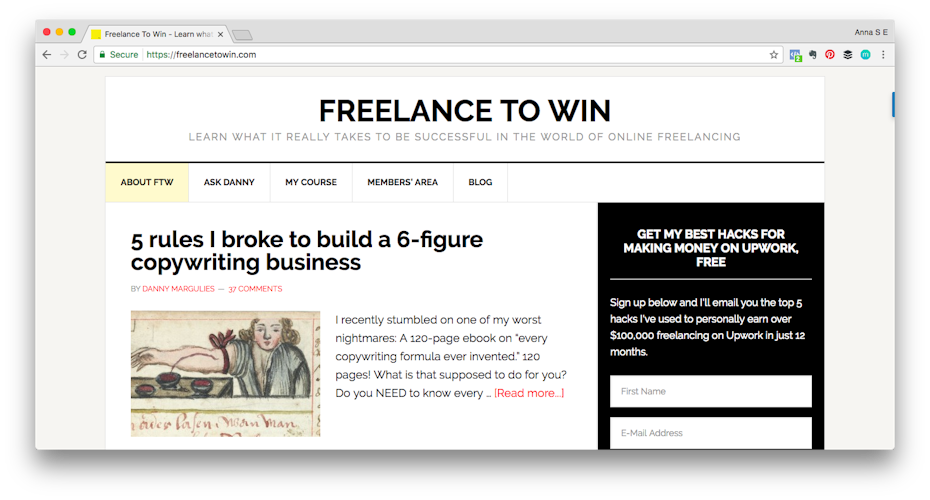
As a freelancer working on a project-to-project basis, a personal brand is absolutely critical. Your personal brand will help raise awareness that you exist and will build credibility and trust so that more clients seek out your services. Ultimately, a strong personal brand means that clients will come to you instead of you having to hustle to find them—saving you time and money.
Personal branding for entrepreneurs & business owners
As a business owner, you should already be building your business brand. Your brand strategy will include your overall purpose and your values, the benefits that your brand stands for and how you’re different from your competition, as well as tangible elements like your logo and the colors and typography found throughout all of your materials. But behind your business brand there’s also a personal brand.
Look at Richard Branson. He has 11.3 million followers on Twitter—compare that to the Twitter accounts of his properties Virgin Atlantic (556K), Virgin Galactic (171K) and Virgin Media (225K). As he declares on his profile, he is a “tie-loathing adventurer, philanthropist & troublemaker, who believes in turning ideas into reality.” Branson uses his personal brand to support his different ventures and to get people to buy into his companies.

People are naturally interested in other people and their stories. They want to know why you set up your business in the first place, what you stand for and what talents and quirks you bring to the table. Cultivating a strong personal brand will humanize your business and allow you to develop stronger relationships which will lead to broader exposure.
As an entrepreneur, you’re also likely to start more than one business over the years. Your current business venture may fail (hopefully not!) and you may sell your shares and move on to your next project—but your personal brand lives on.
2. Take control of your P.I.E.
—

Unfortunately working hard or having great ideas is rarely enough these days. No matter what you do or what your goal is, the secret is to be in control of your P.I.E.: Performance, Image and Exposure. All three pieces of your professional P.I.E. need to work in your favor if you want your personal brand to succeed.
Performance is fundamental, of course. You need to deliver quality results in your work. Image is about what other people think of you—it’s your personal brand! And the final piece, Exposure, is about making sure that people know who you are and what you stand for (I’ll show you how, below).
Try to figure out where you can improve: do you deliver top results, but your image isn’t great? Is your image fine, but you’re lacking exposure? You need to pay attention to all three for the best results.
3. Find your brand story and create your brand framework
—

Before you start telling your story, you need to work out what that story will be. What do you want to be known for? What will make you stand out against your competition? It’s important that you develop a deep understanding of your brand personality and personal brand identity.
A personal brand framework, or story, consists of a number of key elements:
Brand purpose
What is your overall purpose, your ‘why’? Why do you get up in the morning and go to work? What is it that you’re ultimately trying to achieve? This could be professional success or helping or supporting others with your product or service.
Core values
Brands are more and more value driven today and your personal brand must be even more so. What do you want to stand for? What do you value most of all in your personal and professional life? Creativity and innovation? Integrity and respect? Discipline and dependability? Try to come up with five core values.
Brand benefits and reasons to believe
A brand needs to be clear about the functional and emotional benefits it delivers to its customers. When it comes to your personal brand what are the hard and soft skills that you bring to the table? What are your unique strengths? Hard skills are applicable things like (in my case) writing, coaching and mentoring, public speaking, workshop facilitation, business strategy, branding and marketing. Soft skills are attributes like self-motivation, strength, independence, quick thinking and open mindedness.
Next, you’ll want to consider the evidence you have to support those claims. What awards and accolades do you have? What qualifications or client testimonials? Make a list of all of your degrees, awards, credentials, testimonials, prominent media appearances and key examples of your work (i.e. a YouTube channel with your best speaking engagements or a professional blog that features your top writing examples).
Tangible branding elements
Finally, a brand will always have tangible elements like a brand name, logo, colors and fonts—your brand design. What are the tangible elements of your personal brand?
Online, this will include the colors and design elements you use on your website and social networks. Many freelancers who build a brand off of their name also get a personal logo design to use on business cards, their website, etc. Offline, personal branding encompasses your physical appearance including your grooming, the clothes you wear and how you speak, as well as any memorable personality quirks!
Creating a personal brand framework
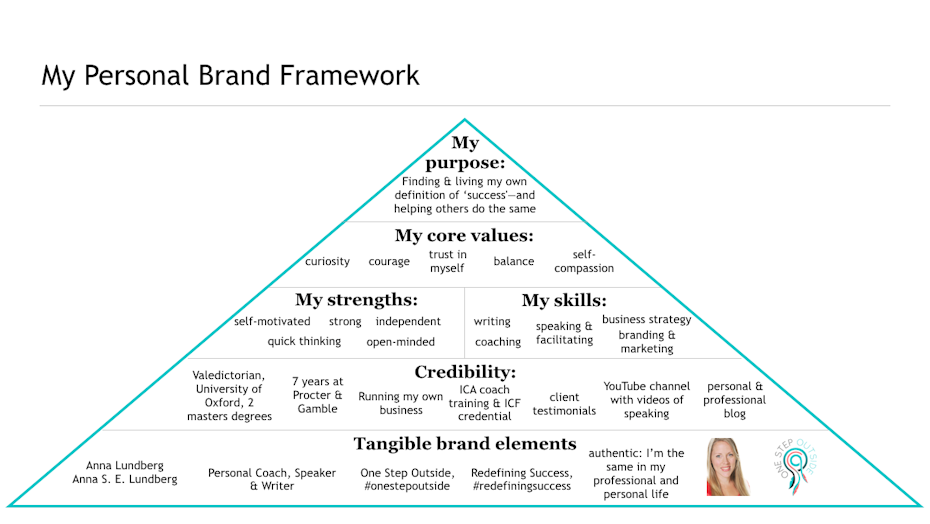
Create your own personal brand framework (you can follow the format of mine or create your own format), print it out and stick it up where you can see it. As you would with a business brand, you can now use this personal branding framework to guide all that you do, bringing your online and offline personal brand in line with your best self.
What sets your personal brand apart?
Now consider your brand story and framework in comparison to everyone else in your chosen field. What’s special about you? Why should someone choose to work with you instead of your competitors?
Companies often call this their “USP”, their Unique Selling Point and it’s particularly important in a crowded industry. Are you the only one in your industry with a sense of humor? Do you have a unique perspective or special skill that no one else has to offer? Your personal branding should clearly demonstrate what makes you different and put your USP front and center.
4. Assess your personal brand as it stands today
—
Now that you have created the story that you want to tell, let’s take a look at the story that’s currently being told today.
What does Google say?
How would you go about finding out more about someone? You’d Google them, right? It’s pretty standard. In fact, 70% of employers use Google to check you out while 70% review your social media profiles as part of the hiring process.
This is officially an excuse to Google yourself! What comes up first? Is it your personal Facebook profile or your LinkedIn page? Click on the Google images tab: which photos do you see—are they pics that you want professional contacts to see?! Do you even show up at all or are the search results dominated by someone else with your name?
If the picture that’s being presented on Google is far from the professional image you want to project, or if you’re not appearing at all, then you have some work to do!

What story are you telling on social media?
Now let’s review your social media profiles and see what story you’re telling there.
Facebook is often the biggest culprit. Your profile might be full of rants about some injustice against your local team or drunken photos with the guys at a sports bar. Maybe you complain about having to go to work with a huge hangover every Monday morning or you post lots of cat videos. What about those flirtatious group selfies when you’re out with the girls? Now is the time to consider the image that might form in the minds of prospective clients, partners, investors or employers when they see these pictures and updates.
Consider setting up a separate page for your business persona and limit your existing Facebook profile with strict privacy settings. That way, only your closest friends and family will see your selfies and rants. (Or, better yet, keep them to yourself!)
The other big one is LinkedIn. Is your profile up to date? What’s the message coming through in the recommendations and in any updates? What kind of content are you liking and commenting on? An out-of-date and inactive—or super negative—profile doesn’t make a great impression.
What would a prospective employer or client think of you based on what they find online? Repeat this assessment of all of your social media profiles and make a note of any changes you’d like to make. Read more about social media branding here.
How do you come across IRL?
When it comes to your offline presence, it’s a little harder to assess what story you’re telling.
Try asking your colleagues, friends, business associates and former clients how they’d describe you if they were to recommend you to someone—see if they mention the key points that you want to be pushing.
Pro tip: don’t try to be someone you’re not, most people have a sixth sense for inauthentic behavior. Personal branding works best when you’re being authentic and not trying to play a role you think you should be playing.
It’s also useful to take an honest look at your physical appearance. Are your clothing and accessories (this includes any tattoos or piercings) appropriate for the audience you’re trying to appeal to? You may not think looks matter, but people still make a snap judgement about you in the first moments of meeting you. What do you want their takeaway to be?
5. Share your brand story with the world
—
Now that you know how you look to the world today, you can begin bringing your new story to life.
But it’s not just about what you say, it’s how you say it. Be sure to create an appealing look and feel and use a consistent brand voice on any platform you’re active on. Along with your words and actions that’s what going to convey your personality and create a complete image of who you are.

Learn to love LinkedIn
There are so many different social networks out there, but for the professional world LinkedIn is the chosen land. Here are some quick tips:
Invest in a professional photo
It’s worth investing in good photos—at least request the services of a friend who has a proper camera if you don’t want to spend any money. You need good lighting, a neutral background and a nice smile! No pouty duck faces or badly cropped wedding pics please.
And, while we’re at it: whenever you upload a photo of yourself, make sure it’s optimized for search (e.g. anna-lundberg.jpg).
Customize your headline
Come on, you’re so much more than “freelancer” or “side-hustler”! Consider using your elevator pitch—you have one, right?—or at least its key points to capture all that you can do.
And if you’re an employee, don’t lean on your job title. Instead, use words that illustrate the core responsibilities of your job. If you’re trying to start a business or looking to change career tracks you’ll want to use language that will help you ignite the process of moving toward that new direction.
Write a compelling summary
The summary section is the first thing people will see after the title and it’s a prime spot for incorporating the key elements of your personal brand framework. This is your opportunity to let the reader know who you are and to pique their interest so that they dig into the rest of your profile.
The summary should be written in first person (“I work with…”). Think about who you’re talking to and your key messages. Highlight your biggest achievements and if necessary explain any gaps or deviations that might not otherwise make sense in your professional trajectory. Try to provide a call to action, like your email address so you can easily be contacted.
Elaborate on your work experience
Job titles alone don’t say too much, so be sure to continue to tell your story through each of the positions or projects that you note on your profile. Highlight key responsibilities and achievements that support your main message (remember that “credibility” piece from your brand framework in #2).
Get recommendations from past employers
Testimonials and reviews are great for building credibility and trust. Don’t be shy about asking people explicitly—even giving them some examples of the kind of things you’d like them to mention. People usually won’t write something unless you ask.
Add your key skills
Make sure that your most important skills and strengths are included in the skills section. You can also shuffle them around so that the three most critical skills appear at the top.
Select your social networks of choice
You won’t have time to actively manage every single network that’s out there so choose carefully. Think about who you are, what type of business or industry you’re in, and who your clients are.

Use that professional picture you’ve had taken and make sure that your Twitter bio captures your story (remember that great example from Richard Branson?) and that your tweets are consistent, too. Add a bit of personality, though, as simply sharing industry articles can get a bit dry! You can pin a key piece of content to the top of your profile to make sure that it’s the first thing peoples see when they land on your profile (instead of your random tweet about the hot guy you saw on the train this morning).

Creating a specific Facebook page for your professional connections is a good idea if you’d like keep your private life private. You can choose an “author” page or “public figure.” Make sure that your ‘About’ section is completed, you’ve linked to your website and you’ve got a high-quality profile picture and cover image. You can (and should!) let your personality shine through here but keep a professional tone and build a page that would make your grandma proud!

If you’re a creative person, or you’re passionate about food, beauty, fashion, and so on, then a more visual platform like Instagram can be a great way to build your personal brand in a beautiful way. Again, make sure that your bio captures the essence of your story and that your pins and posts support that story.
Create a personal website
If you want to get serious about building your brand you need to create a website. It doesn’t have to be fancy—it just needs to look attractive and professional and have your bio, your CV and your contact details, with links to your social network profiles. But you can take it to the next level with additional information, materials, articles and a newsletter—there’s no limit to what you can do!
You can set up a basic site using a website builder or you can create something more sophisticated with a custom web design. No matter which route you decide to take, get a custom domain name (www.janesmith.com rather than www.janesmith.wordpress.com) and get someone to proofread all the copy for you, especially if you’re not a native English speaker (that goes for all online platforms!).
Oh, and while we’re on domains: Please, please, PLEASE don’t use a Hotmail address for professional contacts. It’s embarrassing. Really. Gmail is the standard these days so at minimum you should get something like janesmith@gmail.com. It’s even better if you can secure your own domain name e.g. hello@janesmith.com—oftentimes you can get this along with your website.
And once you’ve done all this great work to update your profiles and platforms you’ll want to make sure that they evolve with you. Be sure to check in now and then and keep your profiles updated.
6. Build your personal brand’s online presence
—
You’ve sorted out all your social profiles so that they’re up to date and telling the right story. Awesome! But while it’s nice to have this basic online presence, if you stop there no one’s going to know that you exist. To make real connections you need to be actively engaging with real people.
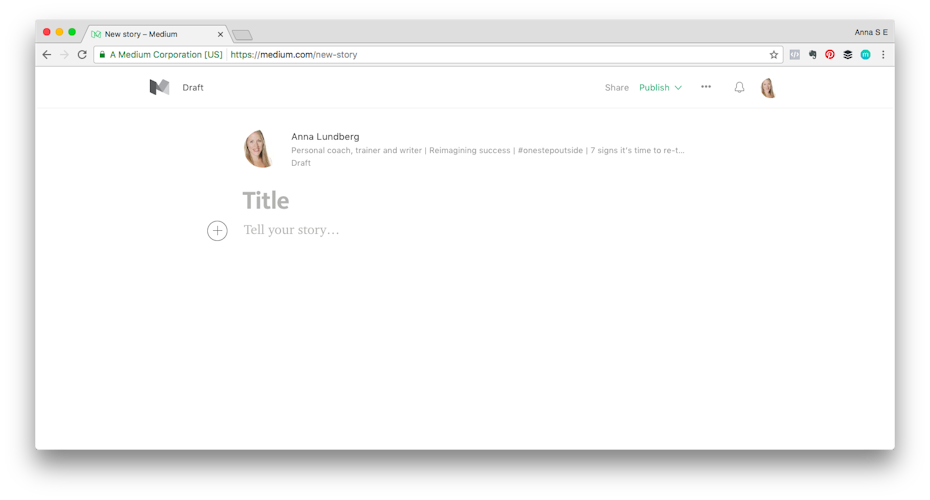
Create relevant content
You can start that process by sharing and commenting on other people’s content that is consistent with your personal brand values and messages. A graphic designer would do well to like a LinkedIn article that promises 7 killer tips for logo design or to add her perspective to a page titled Must-have skills for any graphic designer—but should probably avoid getting sucked into long controversial threads on the policies of the current POTUS. (That last one goes for all of us!)
Once you’re comfortable with this kind of interaction, you can start creating and publishing your own content. It’s completely up to you which format you choose. If you love writing then adding a blog to your personal website could be a good idea, or you could write articles on Medium or LinkedIn. This will also help you show up higher in search rankings. If you’re a bit of a chatterbox, why not try podcasting or vlogging?
Maybe you prefer to hide behind a camera, in which case sharing your beautiful photographs on Instagram might be the best fit for you. You may have to get out of your comfort zone and learn a new skill, but you’ll be surprised at how fast you improve with a bit of consistent practice.
Don’t forget good old networking
Throughout all of these processes, be sure to stay in touch with existing contacts, talk to strangers at conferences and other events and look for opportunities to speak and share your content. A lot of people find networking uncomfortable but it’s really just talking to people—and you can definitely do that! Look for ways in which you can add value and help others and you’ll find that people will do the same for you.
7. Pursue a personal branding strategy
—
Finally, whichever formats and platforms you choose, whatever content you create and put out there, be sure to do so with intention. Each blog post you write, each tweet you send, adds another piece to the puzzle that is your personal brand. Your personal branding strategy is the bigger picture of the brand you want to build.
Having a strategy will keep you on track and ensures you’ll end up where you want to go. It’s your vision and roadmap that everything you do should to fit into.
Now it’s time to take the steps to ensure that the image people end up with is the image you want for your personal brand! Want more branding tips? Here’s how to create a great brand identity for your business.
Article Provided By:99 Designs

If you would like to discuss Your Website Traffic with Mojoe.net or your website’s analytics, custom logo designs, social media, website, web application, need custom programming, or IT consultant, please do not hesitate to call us at 864-859-9848 or you can email us at dwerne@mojoe.net.

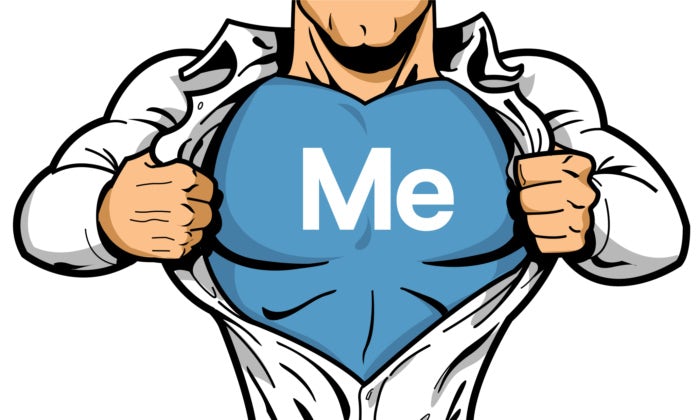
Recent Comments